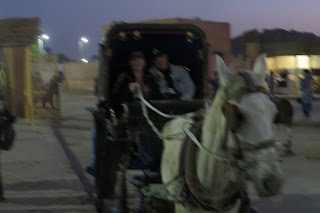Driving out of Tiberius we heard the story of the city over its 2000-or-so-year history. We could see the city walls near our hotel.
Coming into Caesarea-by-the-Sea we saw fish ponds and some of us saw an aqueduct bringing fresh water from the Mount Carmel range.
 We had a really good tour of the site -- the amphitheater, the hippodrome, the palace where a fresh-water pool was surrounded by the salt water sea and the large aqueduct at the beach.
We had a really good tour of the site -- the amphitheater, the hippodrome, the palace where a fresh-water pool was surrounded by the salt water sea and the large aqueduct at the beach.We drove up into Mt. Carmel to a Druze restaurant for lunch. This range of hills is very green and has lots of rain, which is why it's the main water source for the region. This lunch was pretty much like most of the others -- a choice of chicken or falafel on pita, with salad. Those of us with food restrictions have found that we're better off acquiring the makings for our own lunches, then perhaps buying coffee at the restaurant. They don't seem to mind letting us sit with the others while we eat and it saves all the stress of trying to negotiate a meal.

The site of Magdala was discovered by chance, during construction, and consists of a small synagogue, a couple of villas with their own ritual baths, and small homes. The baths have frogs living in them and the water still moves through them.
There is a beautiful, recently-constructed church on the site with a main sanctuary and 4 chapels. The altar in the main sanctuary is in the form of a boat. The pillars in the central area are inscribed with the names of women from the Bible, with one left blank for each of us dedicate to our own mother.
Leaving Magdala, we drove through rich agricultural land where mangoes, bananas and other crops are abundant, some under netting to hold in the moisture. Bananas are in plastic bags to prevent bruising in the high winds that come off the Mediterranean every afternoon.
 Outside the Church of the Beatitudes we gathered and read that passage and had a brief devotion. Inside the church we felt the peace of this beautiful place. In the garden there is a mosaic depiction of the route from the earthly Jerusalem to the heavenly Jerusalem by way of the beatitudes.
Outside the Church of the Beatitudes we gathered and read that passage and had a brief devotion. Inside the church we felt the peace of this beautiful place. In the garden there is a mosaic depiction of the route from the earthly Jerusalem to the heavenly Jerusalem by way of the beatitudes. Yardenit is the baptism site near where the Jordan flows out of the Sea of Galilee. Although it is not the traditional site of Jesus' baptism, it has been well-developed for pilgrims who want to be baptized or to reaffirm their baptismal promises, either by full immersion or by "sprinkling". Five of our group chose immersion and the rest, sprinkling. It was an emotional moment, especially when the group next to us began singing Amazing Grace and we joined in. We eventually exited through the gift shop, and of course there was a bit of shopping.
Yardenit is the baptism site near where the Jordan flows out of the Sea of Galilee. Although it is not the traditional site of Jesus' baptism, it has been well-developed for pilgrims who want to be baptized or to reaffirm their baptismal promises, either by full immersion or by "sprinkling". Five of our group chose immersion and the rest, sprinkling. It was an emotional moment, especially when the group next to us began singing Amazing Grace and we joined in. We eventually exited through the gift shop, and of course there was a bit of shopping.Back in Tiberius we rested for awhile, then met for dinner before returning to our rooms to pack. Tomorrow we have a few more stops in Israel, then will cross back into Jordan. There we will say good-bye to 14 members of this great group before the rest of us continue to Egypt.























































